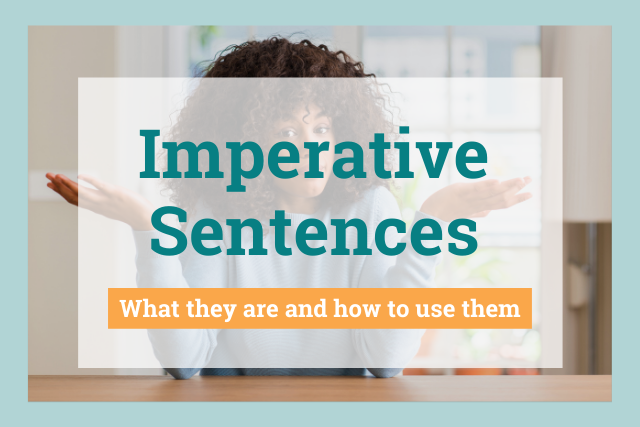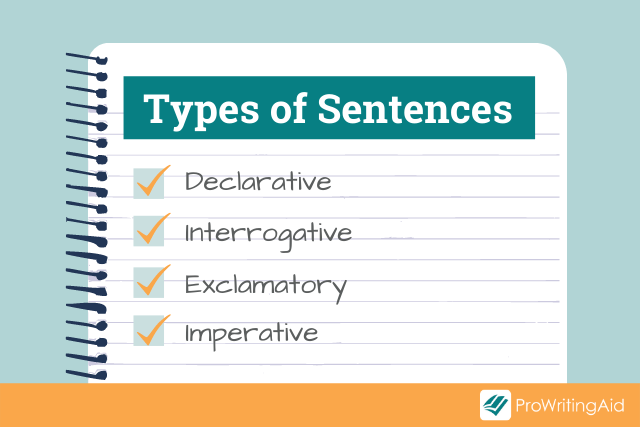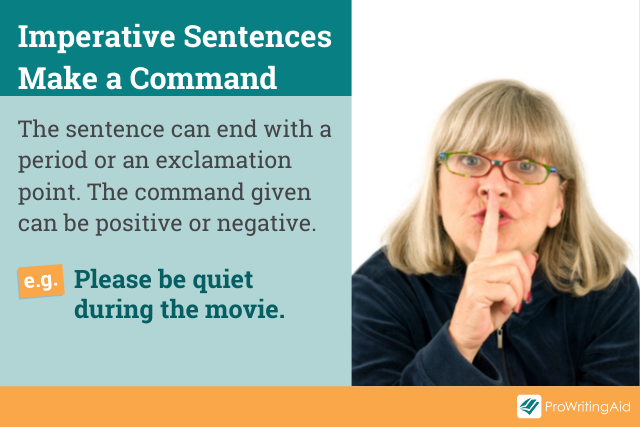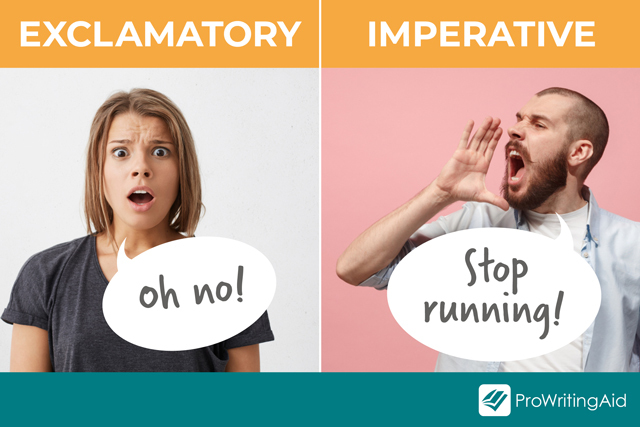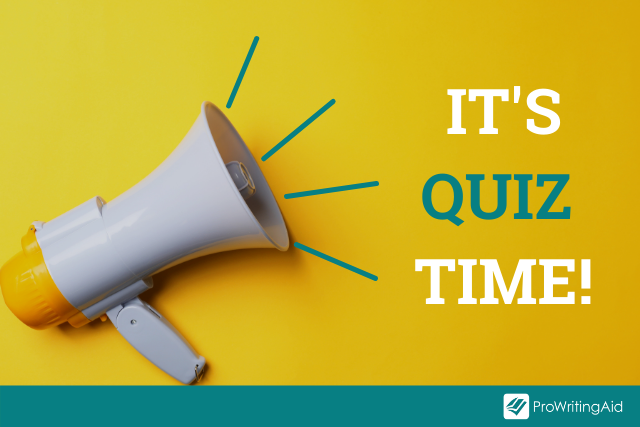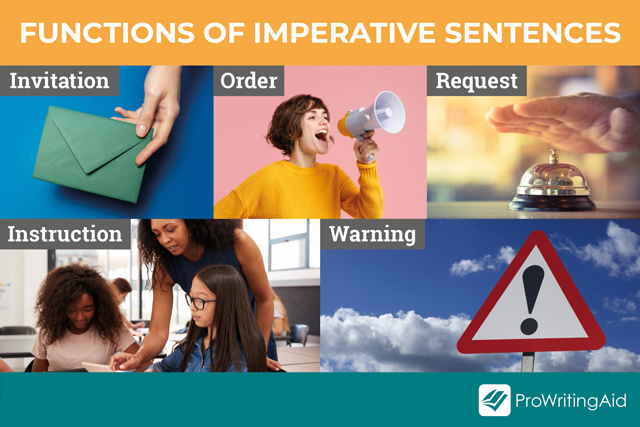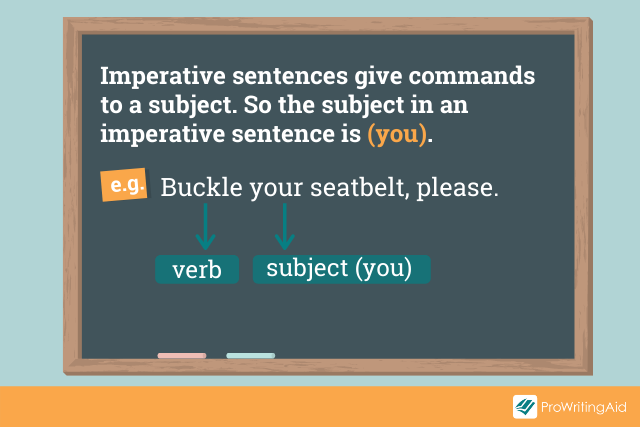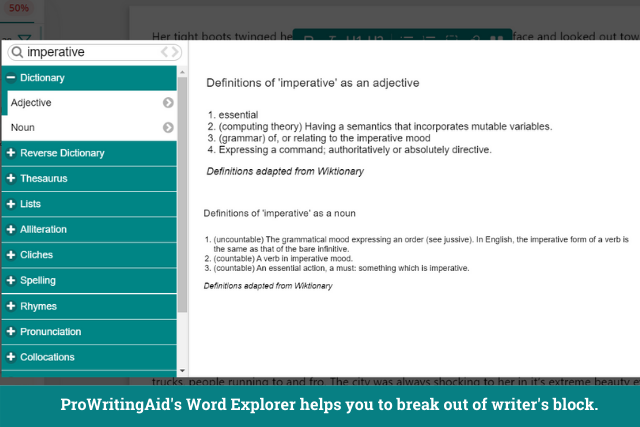Imperative sentences
Данные предложения используются для побуждения человека сделать что-либо. Приказ, просьба, запрет и так далее все они являются повелительными предложениями. Существует два вида повелительных предложений: утвердительные и вопросительные.
Рассмотрим утвердительные предложения:
1). Данные предложения начинаются со сказуемого, подлежащее опускается
Пример:
Give me a pencil- Дай мне карандаш.
Read this article- Прочитай эту статью.
2). Прямой порядок слов
Пример: Don`t forget to call her- Не забудь, позвонить ей.
Вопросительные предложения:
1). В конце повелительных предложений часто ставится will you или won`t you
Open the door, will you? — Откройте дверь, пожалуйста.
Wash the dishes, won`t you?- Помой посуду, пожалуйста.
2). В начале повелительного предложения может стоять will или would
Пример: Would you close the window? — Закройте окно, пожалуйста
Предложения с let`s – давай
Let`s расшифровывается, как let us- позволь нам. После let`s употребляется инфинитив без частицы to.
Пример:
Let`s play piano- Давай поиграем на пианино.
Let`s have a party- Давай устроим вечеринку.
Также в конце предложений с let`s часто употребляется shall we.
Пример:
Let`s dance, shall we? — Давай потанцуем
Let`s go to the park, shall we?- Давай пойдём в парк
В повелительных предложениях можно использовать только let
Пример:
Let her come in- Пусть она заходит!
Let them take it- Позволим взять это.
Часто чтобы выразить повелительную форму, можно просто употребить инфинитив без частицы to.
Пример:
Go left- Иди налево
Write the letter- Напиши письмо
Отрицательная форма в повелительном предложении образуется при помощи вспомогательного глагола do и отрицательной частицы not
Пример:
Don`t do it- Не делай этого!
Don`t cry- Не плачь.
Для того, чтобы усилить просьбу перед глаголом ставится do
Пример:
Do watch this movie- Обязательно посмотри этот фильм!
Do let her come in- Разрешите ей зайти!
- Что такое «повелительное наклонение»?
- Утвердительная форма императива.
- Подлежащее и повелительное наклонение.
- Оборот «let + infinitive».
- Отрицательная форма императива.
- Тест по теме: «Повелительное наклонение (императив) в английском языке»
Что такое «повелительное наклонение»?
В английском языке повелительное наклонение (The Imperative Mood) или императив позволяет побуждать, призывать к действию: говорящий побуждает человека (группу лиц) совершить определенное действие. Слова говорящего могут иметь форму приказания (order), команды (command), предупреждения (warning) или просьбы (request).
Утвердительная форма повелительного наклонения.
В современном варианте языка императив имеет единственную форму, представляющую собой инфинитив глагола без частицы «to». Высказывания в повелительном наклонении адресованы субъекту во втором лице (ед. и мн.ч.) – you (ты, вы). Например,
Be quiet and hear what we tell you. — Успокойся и слушай, что мы тебе говорим. (приказание)
Come along with us. – Пошли с нами. (команда)
Look out! — Берегись! Осторожней! (предупреждение)
Please put the newspaper on the table. – Пожалуйста, положите газету на стол. (просьба)
Для того чтобы сделать просьбу более выразительной и эмоциональной, в утвердительных предложениях используется глагол «to do», который стоит перед инфинитивом. Например,
Do sing again to Mother! — Спой маме еще раз!
Do have a sandwich! – Ну съешь же бутерброд!
Подлежащее и повелительное наклонение.
По правилам английской грамматики, в предложениях с императивом нет подлежащего. Исключение составляют лишь те случаи, когда требуется более эмоциональное воздействие на адресата высказывания. При этом подлежащее ставится перед инфинитивом. Например,
You keep these papers! – Ты сохрани эти документы!
You be more careful! — Ты будь более внимательным!
Следует сказать, что в древнеанглийском языке (Old English) подлежащее, выраженное местоимением (you), всегда употреблялось в предложениях в повелительном наклонении, но стояло оно после глагола. Несколько сентенций сохранились в современном языке, и мы пользуемся ими сегодня:
Mind you! — Имей ввиду! Так и знай!
Go you! — Вперед! «You want to rob the bank? Go you!» — Хочешь ограбить банк? Вперед!
Оборот «let+infinitive».
Команды, приказания, адресованные субъекту в третьем лице (ед. и мн. числа), передаются оборотом «let+infinitive», эквивалентным повелительному наклонению. Глагол «let» находится в начале предложения, за ним следует имя существительное или местоимение в объектном падеже (her/ him/ them) и инфинитив. Например,
Let Nandita leave at once. – Пусть Нандита немедленно уйдет.
Let my children play in this room. — Пусть мои дети играют в этой комнате.
Let her play with your toys. – Пусть она играет с твоими игрушками.
Let them see your review. – Пусть они увидят твою рецензию.
Эта же конструкция используется в отношении первого лица (ед. и мн.ч.). В таких сентенциях после глагола «let» стоит местоимение первого лица (ед. и мн. ч.) в объектном падеже – «me» или «us» и инфинитив глагола:
Let me call off the concert. – Давайте я отменю концерт.
Let’s talk shop. (Let us talk shop.) — Давайте поговорим о делах.
Отрицательная форма повелительного наклонения.
Отрицательная форма императива образуется следующим образом: перед инфинитивом ставится глагол «to do», даже если в предложении есть глагол «to be». Например,
Don’t be silly! — Не валяй дурака! Не говори глупостей! Не глупи!
Don’t talk like that! – Не разговаривай так!
Don’t cut yourself! – Не порежься!
Теоретический материал об императиве в английском языке можно обобщить, посмотрев один из видео уроков по данной теме:
Тест по теме: «Повелительное наклонение (императив) в английском языке»
Из предложенных вариантов ответов для каждого задания выберите верные.
1. What is an Imperative Sentence?
An imperative sentence gives requests, demands, or instructions; or, shares wishes or invitations for others. Basically, they tell someone what to do! As one of the four main types of sentences, they have an important role in both speaking and writing.
Imperative sentences make up a huge part of our everyday language and serve all kinds of purposes!
2. Examples of Imperative Sentences
Imperative sentences are a big part of your conversations and your everyday life, whether you know it or not! Here are some everyday examples:
- Do Not Enter
- Please be quiet in the library.
- Let’s eat.
- Come with me.
- Be nice!
- Help me!
Even common road signs and advertisements use imperatives, like these:

Finally, imperative sentences can even be funny or lighthearted too—you’ve probably seen many versions of the posters below online, on t-shirts, and on signs:
3. Parts of Imperative Sentences
Imperative Mood
All imperative sentences include verbs written in what is called an “imperative mood,” meaning they give commands. Some of the big ones that you use are “don’t,” “please,” “go,” and so on. Imperatives tell someone what to do or not to do. Look at these two sentences:
- Don’t feed the dog. Imperative verb “don’t” expressing a command
- He didn’t feed the dog. Indicative verb “didn’t,” reflecting a lack of action
Imperative verbs give commands, while indicative verbs “indicate” (show) things that happened. So, you can’t use an indicative verb to tell someone what to do. Here are some more examples of verbs in the imperative mood:
- Please be quiet.
- Let me help you.
- Go away!
- Have fun!
- Wait for me!
4. Types of Imperative Sentences
As mentioned above, imperative sentences
- relay instructions
- relay requests
- relay demands
- share invitations
- share wishes for someone.
a. Share a request or wish
There are several types of imperative sentences that each work in different ways. Here are some imperative sentences that share polite requests or wishes for someone:
- Have fun at the fair tonight!
- Eat lots of popcorn!
- Have a safe trip!
b. Share an Invitation:
Here are some imperative sentences that extend an invitation to someone (notice that they are not in the form of questions).
- Come to the fair with me!
- Please join us for dinner.
- Let’s go to the fair together.
c. Share a request or command
Here are some imperative sentences that each share a request or command (notice that these are more firm requests).
- Please don’t give the dog popcorn.
- Go find the dog at the fair.
- Eat your popcorn.
- Stop feeding the dog!
d. Give instructions
Imperative sentences that give instructions are very common, like driving directions or a recipe:
- Preheat the oven.
- Roll out your cookie dough.
- Cut out the cookies with a cookie cutter and put them on a baking sheet.
- Put them in the oven for about 10 minutes.
- Take the cookies out when they are golden.
- Let them cool, and then eat them with milk.
As you can see, imperative sentences can relay all kinds of information.
5. How to Write an Imperative Sentence
Writing an imperative sentence is a bit different than other types of sentences, mainly because of the subject. Imperative sentences generally begin with a verb, and may seem to be missing a subject! But, that’s because imperative sentences are naturally directed at someone since they give direct orders. Since it is implied that the sentence is directed at a person or group of people, it is usually unnecessary to name the subject.
To make this simpler to understand, let’s try adding a person’s name to the beginning of some imperative sentences:
- Sally, please don’t give the dog popcorn.
- Drivers, drive slowly.
- Sam, eat your popcorn!
- Everybody be quiet!
Now, if you take away the underlined subjects from the sentences above, they still make sense:
- Sally, Please don’t give the dog popcorn.
- Drivers, Drive slowly.
- Sam, Eat your popcorn!
- Everybody Be quiet!
You can see that they all still make sense because the imperative verbs let us know that the sentences are commands.
Here are a couple more tips for writing imperative sentences:
a. Decide on tone of voice
Decide which tone of voice is the best match for the purpose of your sentence. An imperative sentence’s tone can be:
- neutral (like a recipe)
- fairly neutral (like a request)
- used to express strong emotions (like a serious command)
b. Decide on punctuation
The sentence’s tone will decide whether it ends in a period or exclamation mark:
- Ask yourself: Is your sentence it a demand, a suggestion, a wish?
- A forceful or demanding tone should have an exclamation mark: Stop feeding the dog!
- A suggestive or polite tone only needs a period: Please don’t give the dog popcorn.
Overall, the tone of an imperative sentence, and its punctuation, are up to you.
6. When to Use an Imperative Sentence
Using imperative sentences is pretty easy—in fact, you do it all the time without even noticing! Here are a few tips for using them successfully:
a. Purpose
Remember their purpose. You can use them to:
- express your wishes for someone
- invite someone to do something
- give requests
- give instructions
- give important demands
b. Subject
Remember that the subject of an imperative sentence is understood, because all imperative sentences are directed at another person or group of people
c. Differences
Remember the distinctions between imperative sentences and other types of sentences:
- Even if it ends with an exclamation mark, an imperative sentence CANNOT be an exclamatory sentence, because exclamatory sentences do not share commands (see below).
- Even if it ends with a period, an imperative sentence CANNOT be a declarative sentence, because declarative sentences only share statements, not commands or wishes.
-
Do you have questions about imperative sentences?
-
Read this post to find answers.
-
It includes plenty of information.
-
It will make understanding imperatives easy!
If you’re really paying attention, you might have noticed that I included an example of each of the four sentence types in that post opener, including an imperative sentence. Read on to learn more and to see over 40 examples of imperative sentences!
What Are the Four Types of Sentences?
These are the categories for the four types of sentences: declarative, interrogative, exclamatory, imperative.
From these descriptions, see if you can determine which type is represented in the four sentences I used to open the post.
- Declarative sentences make a statement or express an opinion. They end with a period.
- Interrogative sentences ask a question and end with a question mark.
- Exclamatory sentences express powerful emotion—surprise, joy, anger, for example—and end with exclamation points.
- Imperative sentences make a command. They can end with a period or an exclamation point.
Take a moment to go back and evaluate the four sentences that opened the post. Then check your answers!
Answers:
1. Interrogative, 2. Imperative, 3. Declarative, 4. Exclamatory
Positive and Negative Imperative Sentences
The command given in an imperative sentence can be positive or negative, meaning it can be a “do” command or a “do not” command. In positive imperatives, the “do” is often implied, meaning the word “do” is not directly stated. In negative imperatives, the “do not” (or don’t) is stated directly.
Example 1:
Positive: Jump in the pool!
Negative: Do not jump in the pool!
Example 2:
Positive: Slow down!
Negative: Don’t drive so fast!
Is It an Imperative or an Exclamatory Sentence?
You’ve likely noticed that some of the imperative sentence examples I’ve given so far end with an exclamation point, but that doesn’t make them exclamatory sentences.
What’s the difference?
Imperative sentences always give commands. Exclamatory sentences don’t.
The purpose of exclamatory sentences is to express observations or make statements with extra emotional intensity, as indicated through that exclamation point. An exclamatory sentence isn’t a command.
The purpose of imperative sentences is to give commands. If the command comes with an exclamation mark, the mark is there to add urgency to that command. To soften the command, use a period. To add politeness, include a “please.”
Imperative Verbs and the Imperative Mood
While verb tenses tell us when a verb occurred or will occur (past, present, future, etc.), verb moods tell us how that verb is expressed.
One of the verb moods is the imperative mood, which is the mood that forms a command. Imperative verbs often start imperative sentences.
For example,
- Stop!
- Give that back!
- Clean your room.
- Please change the channel.
Yes, “Stop!” is a single verb and a complete sentence all on its own when it is used as a command. (If you’re confused, this will make more sense when you read on about the subject of imperative sentences, so keep going!)
The last example starts with “please,” but don’t let that word distract you. The purpose of the sentence is still to issue a command, and the imperative verb “change” leads that command.
Imperative or Exclamatory? Test Yourself!
Which of these sentences are examples of imperative sentences? Which are examples of exclamatory sentences? Give yourself bonus points if you can identify the movies examples 7–15 are from!
-
The rainbow is gorgeous!
-
Take a picture of the rainbow!
-
I missed the turn!
-
Turn left!
-
Don’t drink the water!
-
This water tastes disgusting!
-
They may take our lives, but they’ll never take our freedom!
-
Say hello to my little friend!
-
You’re gonna need a bigger boat!
-
Pay no attention to the man behind the curtain!
-
I’ll get you, my pretty, and your little dog too!
-
Here’s Johnny!
-
To infinity and beyond!
-
Run, Forrest, run!
-
(a) Look at me. (b) Look at me. (c) I am the Captain now!
Answers:
1. Exclamatory, 2. Imperative, 3. Exclamatory, 4. Imperative, 5. Imperative, 6. Exclamatory, 7. Exclamatory, 8. Imperative, 9. Exclamatory, 10. Imperative, 11. Exclamatory, 12. Exclamatory, 13. Exclamatory, 14. Imperative, 15. (a) Imperative (b) Imperative (c) Exclamatory
Bonus points for the films:
7. Braveheart, 8. Scarface, 9. Jaws, 10. and 11. The Wizard of Oz, 12. The Shining, 13. Toy Story, 14. Forrest Gump, 15. Captain Phillips
What Are the Functions of Imperative Sentences?
The function of imperative sentences is to give commands, but that doesn’t mean they only do the work of drill sergeants or bossy older siblings. Imperative sentences, and the commands they give, have distinct tones and intents and generally fit into one of the following categories:
-
Invitation: Commands can be welcoming! When your friend says “Come over and swim in my pool tomorrow” they are issuing a generous command: an invitation.
-
Order: This would be the work of that bossy sibling. “Get out of my room!” or “Tell Mom I’ll be home later.”
-
Request: Think of this as a more polite order. A doctor’s office may leave a voicemail saying, “Please call us back at your earliest convenience” or send an email stating “Please use cash or credit card to pay your balance.”
-
Instruction: Learning how to bake at grandma’s house? She might say “Now mix in the chocolate chips,” as a command of instruction.
-
Advice or Warning: Good friends give honest advice—“Change your outfit”—and (hopefully) wise warnings: “Don’t go out with him (or her).”
Who Is the Subject of an Imperative Sentence?
Every sentence has a subject and verb, and expresses a complete thought. The verb tells us what the subject is doing or what state of being the subject holds.
- She owns the company. (declarative sentence)
Subject = She, verb = owns
- Johnny buckled his seat belt. (declarative sentence)
Subject = Johnny, verb = buckled
- The mountain is so high! (exclamatory)
Subject = mountain, verb = is
Imperative sentences, though, aren’t about a subject; they give commands to a subject. So who is that subject on the receiving end of the command?
The answer: “you.” In proper grammatical terminology, that subject is known as “you understood” and is written as (you).
Let’s take the declarative sentence about Johnny and turn it into an imperative. Imagine you’ve loaded Johnny into his seat and say,
- “Buckle your seat belt, please.”
Subject = (you), verb = buckle
And that same subject (you) would also be the subject for the sentence Stop!
But what if you had said, “Johnny, buckle your seat belt, please.” Is the subject now Johnny?
Nope. Grammatically, the subject is (you) as it is for all imperative sentences, even if a specific audience is included in the statement.
- Everyone hide!
- Passengers, please remain seated.
- Don’t speak in that tone, Pat.
In each of these examples, as with almost all imperative sentences, the command is given from the second-person point of view—the speaker is talking to (you)—and the subject is simply (you).
How Is the Word Imperative Used in a Sentence?
So far, you’ve seen the word “imperative” used to define or label a type of sentence, and you know sentences categorized as imperative express urgent, or at least important, commands. The words “urgent” and “important” help clarify what “imperative” means when it is used in a sentence rather than to identify a type of sentence.

- an adjective that means “extremely important or urgent”
- a noun that means “something that needs to be done or given attention immediately”
- a noun identifying the grammatical mood of a verb (we’ve covered this one already)
Examples of the Word Imperative Used as an Adjective
- Food and water are imperative for survival.
- If you want to get better, taking your medicine is imperative.
- “It is imperative that the governing bodies take note of these findings and work together to protect athletes now and in the future.” (Professor Rick Molloy in sciencedaily.com)
- “For me, it’s morally imperative that we raise the minimum wage to a living wage that’s at least $15 an hour.” (Bernie Sanders in The Guardian)
Examples of the Word Imperative Used as a Noun
- Ending gun violence is not an option, it is an imperative.
- Self-care is an imperative for those who want to live happy and healthy lives.
- “Sleep is not optional. It’s a health imperative, like eating, breathing and physical activity.” (Dr. Judith A. Owens, The New York Times)
- “Minimum-wage workers and activists say $15 an hour is a moral and economic imperative.” (businessinsider.com)
And here’s a double-dipper just for fun:
- If you’re a drill sergeant, it is imperative that you know how to give imperatives.
If you still find that you’re not clear on all the definitions, ProWritingAid offers an easy fix. The Word Explorer is your one-stop for all things definitions, synonyms, examples, rhymes, collocations, quotes, and more. Request a free trial and try it today!
Imperatives Are Everywhere!
Imperatives comprise a significant amount of our everyday communication. We regularly use words to give orders, make requests, extend invitations, provide instruction, and offer advice.
You’ve probably said things today that reflect the commands given in some of these imperative sentences:
- Pass the TV remote.
- Be kind.
- Turn up the music!
- Tell me more.
- Come over for tea.
- Read a book.
- Stop whining!
- Watch this!
Pay attention and you’ll quickly realize we are immersed in imperatives (that was one right there!). Listen to yourself and others (there’s another). Be aware as you read books, watch movies, and sing along to music (and another), and you’ll find imperatives everywhere.
Take your writing to the next level:
20 Editing Tips from Professional Writers
Whether you are writing a novel, essay, article, or email, good writing is an essential part of communicating your ideas.
This guide contains the 20 most important writing tips and techniques from a wide range of professional writers.

Повелительное наклонение выражает в большей или меньшей степени побуждение к действию. Оно может проявляться в форме просьбы, совета, приглашения, приказа или запрета. Мы рассмотрим, когда и в каких случаях употребляется повелительное наклонение в английском языке.
Как образуется и употребляется повелительное наклонение
Повелительное предложение чаще всего обращено ко второму лицу (you – вы, ты, Вы), поэтому в нем, как правило, нет подлежащего. Обращаетесь вы к одному человеку или нескольким, можно понять только по контексту. Другая особенность в том, что у повелительного наклонения нет вопросительной формы, ведь мы употребляем его, чтобы «повелевать», а не спрашивать 
Для того чтобы попросить, посоветовать или приказать что-то сделать, мы используем инфинитив без частички to.
Stand up! – Встань (-те)!
Stop talking! – Прекрати (-те) разговаривать!
Switch off the light. – Выключи (-те) свет.
Be quiet when you enter the lecture hall! – Веди (-те) себя тихо, когда заходишь (-те) в аудиторию.
В предложении в повелительном наклонении может быть обращение. Не путайте его с подлежащим, это не одно и то же.
| Обращение | Подлежащее и сказуемое |
|---|---|
| Alice, close the door. – Элис, закрой дверь. | Alice closed the door. – Элис закрыла дверь. |
| Peter, walk the dog before dinner. – Питер, выгуляй собаку перед ужином. | Peter was walking the dog before dinner. – Питер выгуливал собаку перед ужином. |
Если вам необходимо использовать два глагола в повелительном наклонении, поставьте между ними союз and.
Go and tell him to come back. – Пойди скажи ему, чтобы он возвращался.
Sit down and have a rest, you look tired. – Сядь отдохни, ты выглядишь уставшим.
С помощью отрицательных предложений мы будем налагать запреты, просить или советовать чего-то не делать. Для того чтобы образовать отрицание, мы ставим в начало предложения вспомогательный глагол do и частицу not (don’t).
Do not use cellphones here. – Не пользуйтесь здесь мобильными телефонами.
Don’t come in, the floor is wet and slippery! – Не входи, пол мокрый и скользкий!
Don’t bother her. She’s in a bad mood. – Не доставай ее. Она в плохом настроении.
Вежливые формы повелительного наклонения
Англичане не хотят казаться грубыми и неучтивыми. Поэтому они стараются смягчить повелительную фразу и добавляют к ней слова вежливости, такие как please, just, if you don’t mind. Мы можем их перевести как «пожалуйста», «если ты (Вы) не против».
Please close the window. – Пожалуйста, закройте окно.
Put the cup on the table, please. – Поставь, пожалуйста, чашку на стол.
Don’t share this information with him, if you don’t mind. – Не сообщай ему об этом, если ты не против.
Just buy two tickets to the cinema, please. – Купи два билета в кино, пожалуйста.
Please don’t give my cat leftover chicken, if you don’t mind. – Пожалуйста, не давайте моей кошке остатки курицы, если Вы не против.
Другой способ добавить повелению вежливости – сделать его разделительным вопросом. Добавьте «хвостик» к предложению, и оно станет на порядок мягче. Самые частые «хвостики» – will you, won’t you, can you. Об этом типе вопросов можно почитать в нашей статье.
You’ve almost succeeded. Take another effort, will you? – У тебя почти получилось. Сделай еще одну попытку, хорошо?
Don’t mention it ever, will you? – Не вспоминай об этом никогда, хорошо?
Give me my glasses, can you? – Можешь передать мне очки?
Иногда повелительное наклонение используется для того, чтобы что-то предложить или пригласить куда-нибудь.
Have another cup of tea. – Выпей еще одну чашечку чая.
Come to my birthday party tonight. – Приходи на празднование моего дня рождения сегодня вечером.
Повелительное наклонение с let
Если нам необходимо обратиться к первому лицу (I – я , we – мы) или третьему (he – он, she – она, it – оно, they – они), на помощь приходит глагол let (позволять). Если мы говорим о своем действии, за let будет следовать местоимение me (мне).
Let me buy you a present. – Дай мне купить тебе подарок.
Let me help you. – Позволь мне помочь тебе.
Если мы приглашаем кого-то к совместному действию, то глагол let и местоимение us (нам) образуют форму let’s. В формальном контексте мы будем использовать полную форму let us.
Let’s go to the cinema on Saturday. – Давай пойдем в кино в субботу.
Let us begin the annual conference on computer technologies. – Позвольте нам открыть ежегодную конференцию по компьютерным технологиям.
В разговорной речи let’s очень часто обозначает первое лицо единственного числа (I – я).
Let’s see what’s with your hand. – Дай я посмотрю, что с твоей рукой.
Также let’s мы употребляем в кратких ответах вместо yes, когда отвечаем на чье-то предложение.
– Shall we have a break in ten minutes? – Сделаем перерыв через десять минут?
– Let’s. – Давай.
В отрицательных предложениях встречается две формы: let’s not и don’t let’s, вторая считается более формальной.
Let’s not forget to buy milk this time. – Давай в этот раз не забудем купить молоко.
Don’t let’s remind them of the failure. – Давайте не будем напоминать им об этой неудаче.
В третьем лице местоимения he, she, it, they трансформируются в him, her, it, them. Мы ставим их после глагола let. Также после let может стоять имя человека или существительное. Хотя следует упомянуть, что с третьим лицом повелительное наклонение встречается не так часто в английском языке.
Let your children have fun on the playground. – Позволь детям повеселиться на площадке.
Don’t let Jill believe his words! – Не позволяй Джил поверить его словам!
The vase is expensive. Don’t let it fall down. – Ваза дорогая. Не дайте ей упасть.
Эмоциональные формы повелительного наклонения
Если ваше указание осталось без должного внимания, вы всегда можете добавить ему эмоциональности, для этого используйте одну из следующих конструкций:
- Усилительный глагол do
Когда вы хотите подчеркнуть важность вашей просьбы или приказа, используйте усилительный глагол do в начале предложения. В этом случае do может выполнять две функции: показывать нетерпение или делать обращение вежливым и формальным.
Do read this book! – Обязательно прочитай эту книгу!
Do stand up when you listen to the national anthem! – Да встань же ты, когда слушаешь национальный гимн!
Do take your places. We begin the play. – Прошу занять ваши места. Мы начинаем представление.
Мы также можем использовать do без глагола в кратких ответах.
– Can I take the book you told me about yesterday? – Я могу взять книгу, о которой ты мне вчера рассказал?
– Do, it’s on the shelf. – Бери, она на полке. - Повеление с подлежащим
Если вы хотите добавить своему высказыванию сильную эмоциональную окраску, ставьте перед глаголом подлежащее you.
You leave him alone! – Да оставь ты его в покое!
You get out of here now! – Сейчас же убирайся отсюда!
В отрицательных предложениях you может стоять перед или после don’t.
You don’t go, I‘ll be there in a minute! – Не смей никуда уходить, я буду там через минуту!
Don’t you touch the pictures in the gallery! – Не смей трогать картины в галерее!
Еще в качестве подлежащего мы можем использовать someone/somebody (кто-то), everyone/everybody (все), no one / nobody (никто).
She is going to pass out. Somebody call a doctor! – Она сейчас потеряет сознание. Кто-нибудь, вызовите врача!
Nobody move! It’s a robbery! – Никому не двигаться! Это ограбление!
- Повеление с наречием
Мы можем усилить наше предложение наречиями always (всегда) и never (никогда), которые поставим перед глаголом.
Always wash up after dinner. – Всегда мой посуду после ужина.
Never tell her your secrets. She’s a gossip. – Никогда не рассказывай ей своих секретов. Она сплетница.
И последнее, что я хочу сказать: никогда не пренебрегайте тестом 
Тест
Imperative mood. Повелительное наклонение в английском языке
Если вы нашли ошибку, пожалуйста, выделите фрагмент текста и нажмите Ctrl+Enter.




